
-
Find the right food for your pet
Take this quiz to see which food may be the best for your furry friend.
Find the right food for your pet
Take this quiz to see which food may be the best for your furry friend.
Featured products
 Adult Healthy Cuisine Roasted Chicken, Carrots & Spinach Stew Dog Food
Adult Healthy Cuisine Roasted Chicken, Carrots & Spinach Stew Dog FoodDelicious roasted chicken paired with tender vegetables in a succulent stew
Shop Now Adult 7+ Perfect Digestion Chicken, Whole Oats & Brown Rice Recipe Dog Food
Adult 7+ Perfect Digestion Chicken, Whole Oats & Brown Rice Recipe Dog FoodScience Diet's breakthrough nutrition supports ultimate digestive well-being & healthy microbiome for dogs age 7+
Shop Now Small & Mini Savory Stew with Chicken & Vegetables Dog Food
Small & Mini Savory Stew with Chicken & Vegetables Dog FoodA delicious complement to the nutrition of Science Diet Small & Mini 7+ dog food
Shop NowFeatured products
 Adult 7+ Senior Vitality Chicken & Vegetable Stew Cat Food
Adult 7+ Senior Vitality Chicken & Vegetable Stew Cat FoodImproves Everyday Ability to Get Up & Go
Shop Now Adult Savory Entrée Can Variety Pack Cat Food
Adult Savory Entrée Can Variety Pack Cat FoodPrecisely balanced nutrition with the delicious taste of savory minced chicken to help fuel the energy needs of cats during the prime of their life
Shop Now Adult 7+ Tender Tuna Dinner Cat Food
Adult 7+ Tender Tuna Dinner Cat FoodWith delicious chunks in a decadent gravy
Shop Now -
Dog
- Dog Tips & Articles
-
Health Category
- Weight
- Food & Environmental Sensitivities
- Urinary
- Digestive
- Joint
- Kidney
-
Life Stage
- Puppy Nutrition
- Adult Nutrition
- Senior Nutrition
Cat
- Cat Tips & Articles
-
Health Category
- Weight
- Skin & Food Sensitivities
- Urinary
- Digestive
- Kidney
-
Life Stage
- Kitten Nutrition
- Adult Nutrition
Featured articles
 Why Are Dogs and Cats So Cute?
Why Are Dogs and Cats So Cute?If waggy puppy dog tails and furry kitten yawns make you swoon, you're not alone. Why are cats so cute? And, dogs too! Let's find out!
Read More Do Dogs and Cats have Belly Buttons?
Do Dogs and Cats have Belly Buttons?Learn whether cats & dogs have belly buttons like humans, what the function is, and if there are any health concerns associated with it.
Read More Does My Pet Hate Me?
Does My Pet Hate Me?Learn tips for bonding with your pet if you've ever thought, 'My dog doesn't like me, or 'Why do I have a standoffish cat?'
Read More -


It's easy for cat parents to think of their fur babies as just that: babies. But as your cat grows up, it's important to feed them the right amount of food for each stage of life — you wouldn't feed a kitten the same amount you would a senior cat. Wondering how much to feed a cat that's not a youngster but not yet in their golden years? This guide will help you make decisions about how much and when to feed your adult feline friend.
Deciding How Much to Feed Your Cat
Cat's reach "adulthood" by their first birthday, but it can take a few years to outgrow some of their spunk. The time between their first and third birthdays is sometimes referred to as the "junior" phase. Cats are still pretty active, but they are no longer growing. The "prime" of a cat's life often though of as the time between years three and seven. This stage can be considered the "maintenance" stage as their activity level has often moderated some. A cat's feeding routine should be matched to their stage of development and activity level.
Consider calories as opposed to food portions, recommends Cummings Veterinary Medical Center at Tufts University, emphasizing that "the actual amount of calories that your pet is eating and their weight and body condition score is going to be a better indicator of what your pet actually needs." In other words, take your cue from your cat.
When making decisions about food portions, take into consideration these three factors: weight, health and activity level. Depending on your cat's breed, they may vary in weight, but generally adult cats of a healthy weight and activity level weigh around ten pounds. How much should I feed a cat if they're within normal range? The feeding instructions on your cat's food packaging is a great starting point for portion size.
For example, a ten pound adult cat that has an average activity level requires about 290 k/cals per day. The energy density of cat foods varies, but it is listed on each package. If you feed wet food, it will seem like you have to feed a lot more to meet your cat's energy needs. That is because wet food has water in the food as well as all of the nutrients the cat needs. This can help aid in your cat's need for hydration if they aren't prone to drinking their required amount from a water bowl. Dry foods, on the other hand, have most of the water removed during the cooking and drying process, so they have a much more concentrated source of nutrition. So, while it may look like you're feeding your cat less, they are still getting the required amounts of calories and nutrients when fed a properly balanced meal. Whether you feed wet or dry cat food, make sure to always have fresh water for your cat available at all times. In all instances, speak with your veterinarian about how much to feed your cat for their specific needs. This is especially true for cat is obese or those that have special dietary needs.


Tasty Tips
When Should I Feed My Cat?
When you feed your cat essentially comes down to what works best for their needs. "A variety of feeding styles can maintain good health" in cats, points out the Feline Life Stage Guidelines published the American Association of Feline Practitioners and the American Animal Hospital Association (AAFP-AAHA).
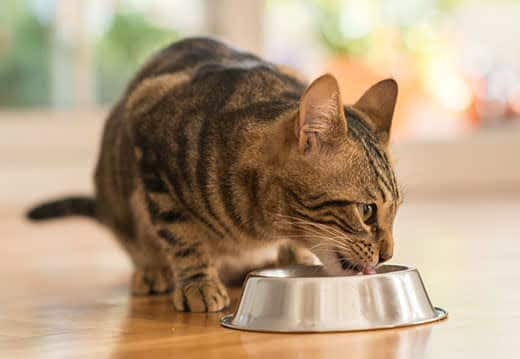
One option is to allow them to eat freestyle with food available 24/7. This method is great if your cat has self-control, but many cats tend to overeat due to anxiety, boredom or health issues. You can also look into automated cat feeders that can regulate how much food your cat eats each day if your cat is prone to overeating.
Breaking up your cat's caloric intake into two or three smaller meals per day works well for most healthy cats, say experts such as Francis Kallfelz, DVM, Ph.D., at the Cornell University College of Veterinary Medicine, as long as they don't have dietary restrictions due to medical issues.
How Do I Choose the Right Cat Food?
When planning your cat's mealtimes, don't just think "how much should I feed my cat?" also consider what goes into the food you're feeding them. Knowing how to read a cat food label helps you decide which food is best for your pet. Make sure to look beyond just the ingredients, and consider the nutrients that they provide. Your cat needs the right balance of protein, fat and carbohydrates. They also require certain vitamins and minerals, like calcium, magnesium and vitamin A.
It's also a good idea to speak with your vet to figure out which type of food is best for your feline friend. Having a clear picture of your cat's health, weight and activity level ensures you choose the food that most benefits your cat's lifestyle.
Is your cat a treat lover? Be sure that treats remain a once-in-a-while delicacy and don't become commonplace. When thinking about how much to feed a cat, calories counts. Approximately 90% of a cat's daily caloric intake should come from well-balanced cat food and 10% (absolute maximum) from treats. If your cat fills up on treats, they're not getting the balanced nutrition they need.
To help your adult cat stay healthy and active, you can use feeding time as enrichment time, too. Some cats eat just because they're bored, so provide them with plenty of opportunities to keep their minds and bodies sharp.


Christine O'Brien is a writer, mom, and long-time cat parent whose two Russian Blues rule the house. Her work also appears in Care.com, What to Expect, and Fit Pregnancy, where she writes about pets, pregnancy, and family life. Find and follow her on Instagram and Twitter @brovelliobrien.
Related products
Related articles
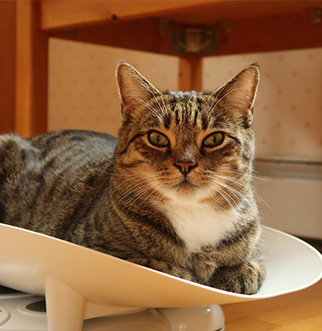
How do you get a cat to lose weight? Learn all about cat foods for weight loss, including how to choose weight control cat food and exercise tips.
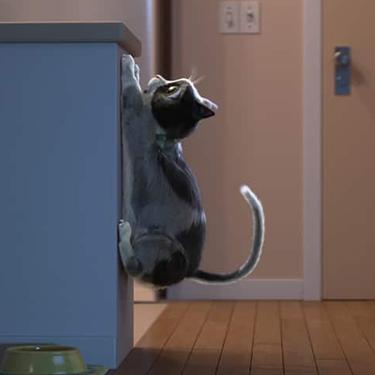
What is the best food for an overweight cat? Learn all about weight control food for cats, including what's in it and how it works.
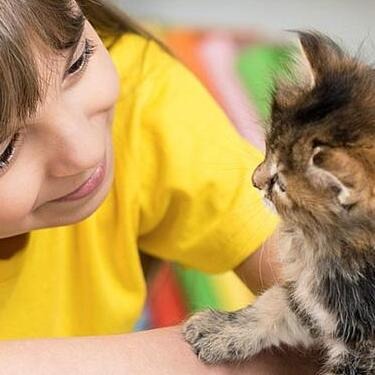
Discover how to train your cat, starting with very basic first steps that both reward good behavior and discourage the bad.
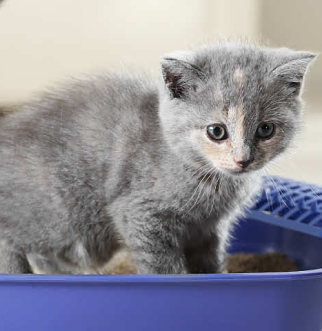
Cats are naturally very clean and chances are your kitten will already have learned how to use the litter box from her mother before she comes to live with you.

Put your cat on a diet without them knowing
Our low calorie formula helps you control your cat's weight. It's packed with high-quality protein for building lean muscles, and made with purposeful ingredients for a flavorful, nutritious meal. Clinically proven antioxidants, Vitamin C+E, help promote a healthy immune system.
Put your cat on a diet without them knowing
Our low calorie formula helps you control your cat's weight. It's packed with high-quality protein for building lean muscles, and made with purposeful ingredients for a flavorful, nutritious meal. Clinically proven antioxidants, Vitamin C+E, help promote a healthy immune system.

